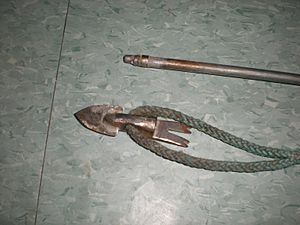Toggling harpoon facts for kids


The toggling harpoon is an old weapon and tool. People used it for whaling to catch large sea animals like whales. What makes it special is its unique two-part tip. One part stays fixed to the harpoon's main pole. The other part fits over the first, like a cap, and is tied with a strong cord, often made from animal sinew.
When a hunter throws the harpoon and it hits an animal, the top part of the tip separates. It then turns sideways inside the animal's body. This clever design helps the harpoon stay firmly stuck. It lodges deep in the animal's muscle, not just the skin or fat. This makes it much harder for the harpoon to slip out, allowing hunters to pull the animal to their boat or the shore.
Contents
History of the Toggling Harpoon
Early Harpoons: Red Paint Culture
The first toggling harpoons appeared a very long time ago. They are linked to a group of people called the Red Paint People. They lived in New England and Atlantic Canada between 5500 BC and 4000 BC. The oldest known toggling harpoon tip was found in Labrador, Canada. It was at a 7000-year-old burial site called L'Anse Amour. These early hunters likely used them to catch animals like swordfish and seals. Scientists have found bones of these animals at Red Paint sites.
Thule People and Arctic Hunting
Later, the Thule people also used toggling harpoons. The Thule culture existed from about 700 BC and continues to this day. They lived in the Western Arctic, especially near the Bering Strait. They also lived along the coasts of Asia and Alaska. The toggling harpoon was a key part of their hunting tools. It helped them hunt sea mammals, which was very important for survival in the Arctic. This tool made life easier for these skilled hunters.
European and American Innovations
Europeans also developed their own versions of the toggling harpoon. By 1772, some European boats used a type called the "grommet iron." This harpoon had an iron head. A grommet (a ring) held the head and the shaft parallel. When the harpoon hit a whale, the grommet slid off. This allowed the head to pivot and catch inside the animal.
A very important change happened in 1848. Lewis Temple, an African-American blacksmith from New Bedford, Massachusetts, improved the design. He added a small wooden pin, called a shear pin, to hold the toggle head in place at first. His invention became known as Temple's Toggle. Later, people just called it the toggle iron or iron toggle harpoon. This new design became the standard for whaling. It replaced older harpoons that had fixed, single or double points.
A Symbol of Whaling
The toggling harpoon became so important to the whaling industry that its shape is still a symbol today. In New Bedford, Massachusetts, there is a statue of a whaler holding a toggling harpoon. This statue has become a symbol for the entire city, showing its strong connection to whaling history.

